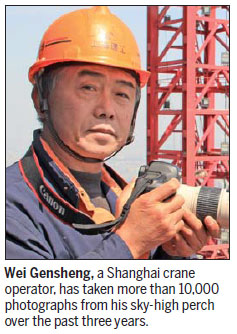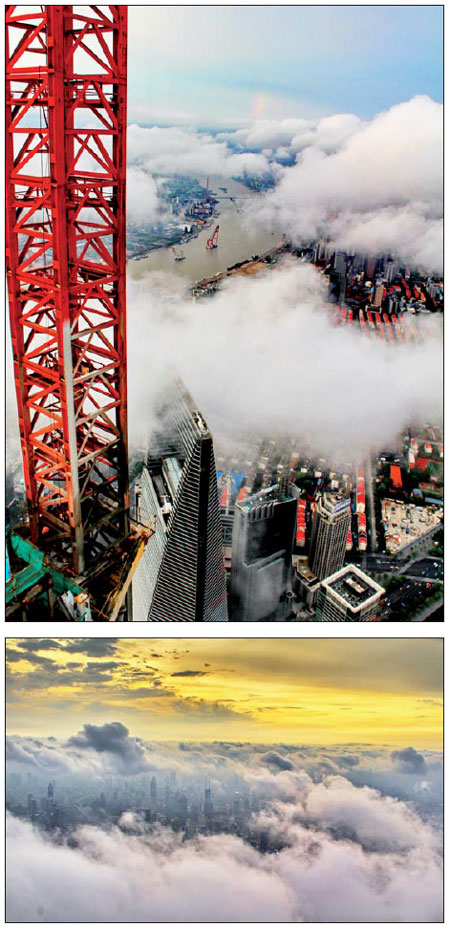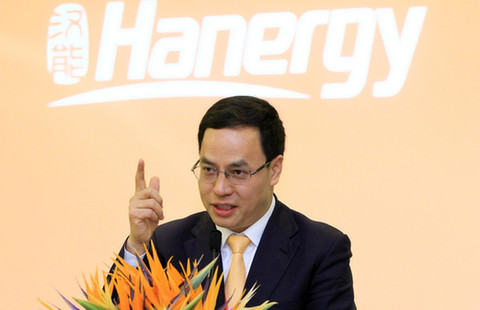

Crane operator's unique perspective on how a city's landscape has transformed over 40 years
A Shanghai crane operator shot to fame last year after a series of photos he snapped from his lofty perch went viral worldwide, making him the face of China's remarkable vertical building boom.
On Sept 21, Wei Gensheng, 59, will pull the plug on a career in construction that has spanned almost 40 years and made him and his camera eyewitnesses to the most extraordinary explosion of urban and economic development in human history.
Looking back over a working life that is entwined with the modern rise of China, he is already pining for the "office" he will leave behind: a 1.8 sqm box, hundreds of meters up in the sky, with some of the most beautiful views in the world.
"The days when I was working high in the sky was the most beautiful time of my life," Wei says. "I enjoyed views that few people could enjoy, and I was also very lucky to be able to record them."
Wei has taken more than 10,000 photographs from his sky-high perch over the past three years, while he was working on construction of the 632 m Shanghai Tower. When it is completed near the end of this year it will become China's tallest building, and second in the world to the Burj Khalifa tower in Dubai.
A selection of about 50 of the photos Wei took on site, primarily using his Canon EOS 550D camera, won him the silver award at the Shanghai International Photographic Art Exhibition last November and turned him into a minor celebrity.
"I took my camera with me so I could take photos during the breaks between working," he says. "I had a unique, advantageous position. I sat there for 12 hours a day watching those beautiful views on sunny, raining and foggy days. They were so beautiful and changeable that I felt I had to record them. I'm glad I did it, because many others may not be able to see them or know how to photograph them."
Wei joined Shanghai Construction Group in 1975 and has worked on many of the company's big-ticket projects, which helped turn Shanghai into a world-class metropolis.
Initially a crane driver on the ground, when Shanghai began to boom upward in 1993, he went with it and became a tower crane driver.
His job mostly involved sitting in a cabin high above ground, taking instructions via walkie-talkie, and delicately operating a crane capable of lifting up to 100 tons, he says.
"Up in the air, the wind can be strong and you swing a lot. I was scared at first, but I gradually got used to it. I've spent one third of my time over the past 15 years up there."
Generally, the schedule in China's construction industry is very tight, he says, and the work demands intense concentration and caution, as one false move can endanger people on the ground.
But in all, he says, life in the clouds was simple and often slightly boring. During each meal break he would lower a 50-meter long rope with a basket on the end. His colleagues would then fill it up with food, and he would haul it back up.
As a Shanghai native he is proud of his contribution to the city's skyline, made during the construction of more than a dozen skyscrapers. And he concedes that compared with other types of work that also require working high in the sky, such as electrical welding, his conditions have been far less difficult, although not without some hardship.
"I wasn't exposed to wind and rain like they are," he says. "But it is still difficult. It is really cold up there in winter. Also when you feel the thunder hit the crane, creating sparks sometimes, or experience violet storms where you sway heavily, those things can be difficult."
However, he says the pride he feels, has made the hardships worthwhile.
"Every time I pass by the buildings I've worked on, I stop and look at them. I have feelings for them. And the harder I work, the stronger the feelings I have for them."
Wei says he thinks the skyscraper boom in China is partly driven by competition, with different cities playing to win.
"It's just like in a village, where neighbors talk about whether their houses are taller than other houses. Actually, making higher buildings doesn't necessarily make more money; it is more about creating an icon for a city. If you compare building a 50-story building and a 100-story one, the cost is not necessarily just double. It may triple."
With retirement day looming, Wei went back to his office in the sky one last time, to share his final view of the skyline with his more than 3,000 followers on Chinese social media site Sina Weibo.
He plans to continue to pursue professional photography in retirement, and tentatively plans an exhibition about his life in the sky.
Contact the writers through chenyingqun@chinadaily.com.cn
|
The spire of Jin Mao Tower, an 88-story giant built in the Pudong New Area, whose shape draws on traditional Chinese forms, especially the tiered pagoda. |
|
Looking over to The Bund, the famous waterfront regarded as the symbol of Shanghai for many years, on the west bank of Huangpu River. Its various buildings of different architectural styles, many built more than a century ago, now sit in stark contrast to the towering structures across on the other side of the river, in the Pudong New Area. Photos by Wei Gensheng / for China Daily |
|
Above and below: Regardless of beating sunshine, driving rain, low-lying cloud or fog, Wei Gensheng says he enjoyed the view from his "office" in the sky that few others ever shared. |

|
Above: The 101-story Shanghai World Financial Center, opened in August 2008 in the Pudong New Area, is often affectionately known locally as "the bottler opener" on account of the "trapezoid aperture" at its peak. Below: The Financial Center acts as a backdrop to the smaller, but no less-spectacular, Jin Mao Tower. |

(China Daily Africa Weekly 09/26/2014 page10)








